Urban beekeeping at RSU: a sustainable balance between nature and city
Linda Rozenbaha,
RSU Public Relations Unit
In May, new buzzing neighbours moved in on the roof of Rīga Stradiņš University’s (RSU) newest and most modern building, the Pharmaceutical Education and Research Centre. Beekeeper Kārlis Krievkalns has placed 16 beehives here, in keeping with the University’s commitment to sustainability through making full use of urban spaces.
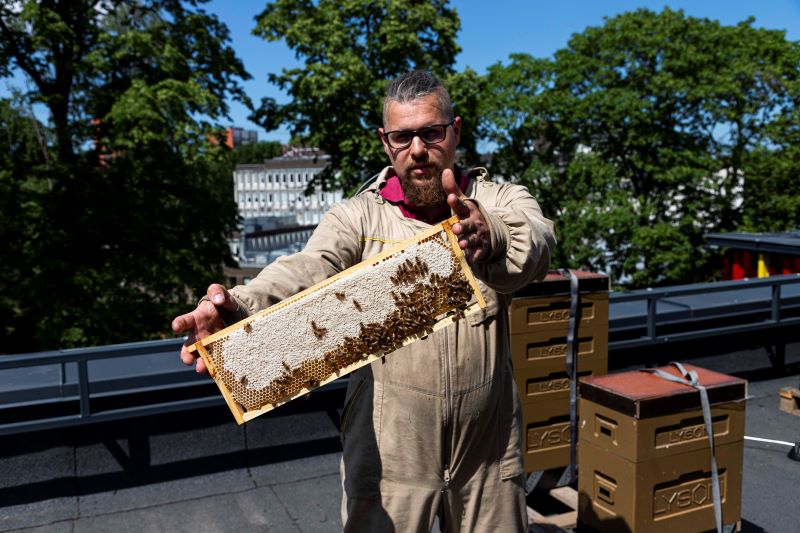 Wearing a protective suit, beekeeper Kārlis Krievkalns holds up some honeycomb crawling with bees. Photo from RSU archive
Wearing a protective suit, beekeeper Kārlis Krievkalns holds up some honeycomb crawling with bees. Photo from RSU archive
We take a closer look at how our black-and-yellow neighbours are faring as the intoxicating smell of lime blossoms fills the courtyard of the University’s main building. Asst. Prof. Agnese Brangule, Lead Researcher at RSU’s Department of Pharmaceutical Chemistry explains how they wanted to prove, and eventually have proven, that honey from Latvia is just as good as the famous manuka honey.
I joined Krievkalns, a beekeeper at SIA Medusmāja, as he went about his regular inspection of the hives. He revealed that there is an interesting pollen that can currently be observed here, near the University of Latvia Botanical Garden:
‘It has a unique colour, similar to the shade of red in the Latvian flag, and is different from meadow pollen.
I have also collected some acacia and rhododendron honey that both grow around here,’ said the beekeeper.
He has already learned to identify the flowers from which the honey is made, even by smell and taste. But of course, there are also rational indicators – if the bees have enough to eat, they typically collect honey within a one-and-a-half to three-kilometre-wide radius, but if food is scarce they can fly as far as seven kilometres.
Beekeepers have distributed around 170 colonies almost all over Latvia, and when food runs out in one place, they move the bees elsewhere. For example, after feasting on lime tree pollen, the bees from the RSU roof will work in the meadows around Stikli where there is heather. ‘In the city, bees find food in flowering trees, as meadows are usually mowed,’ Krievkalns explains.
He also relocates his hives in the countryside when rapeseed fields are sprayed with pesticides. ‘Then I hide the bees in forests to protect them from harm, ensuring that their flight radius doesn’t include fields that have been sprayed. I’ve travelled around half of Zemgale,’ he smiles.
Ironically, pesticides harm bees and honey collection in the countryside, whereas in the city, air pollution, such as vehicle emissions, has not been proven to have a negative impact.
The beekeeper offers to lift the lid off a hive so that photographer Miks Užāns and I can touch the fine mesh surface and feel the air vibrating from the bees.
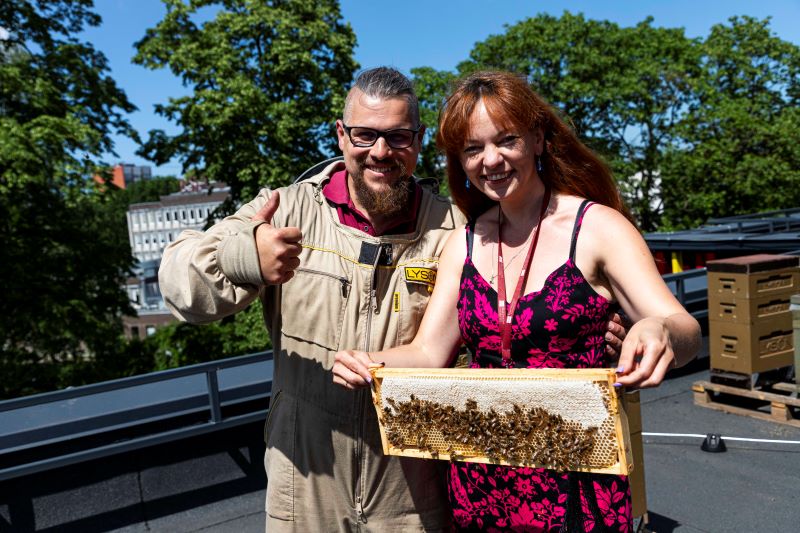 Beekeeper Kārlis Krievkalns and writer Linda Rozenbaha smile, while holding up a frame with honeycomb. Photo from RSU archive
Beekeeper Kārlis Krievkalns and writer Linda Rozenbaha smile, while holding up a frame with honeycomb. Photo from RSU archive
Let's take a step closer to the bees. The beekeeper offers me a protective suit, but since I haven't had any bad experiences with bees, I decline. Instead, I wear my everyday clothes and try to stay calm, as bees pick up on nervous movement and stress. Krievkalns removes a frame crawling with bees. The ones closer to the top are calmer, while those below are older and more skittish.
I asked our photographer to take a close-up of the bees. ‘One portrait of each bee,’ he jokes.
The idea behind the rooftop hives
How did the idea to house bees on the RSU roof come about? According to Dainis Zemešs, Director of the RSU Infrastructure Department, who joined us during the inspection, ‘Pārdaugava, the area around RSU, is very green, with a variety of trees – large trees, fruit trees in allotments, and the trees in the nearby Botanical Garden. Historically, the Dārza, Bumbieru and Ķiršu streets formed the Zasa Manor garden area, which fit well with the proposal to locate the bee colonies here. RSU Vice-Rector Toms Baumanis came up with this idea, and relatively quickly we started looking at the area around RSU for potential places, e.g. roofs, where the bees could live.
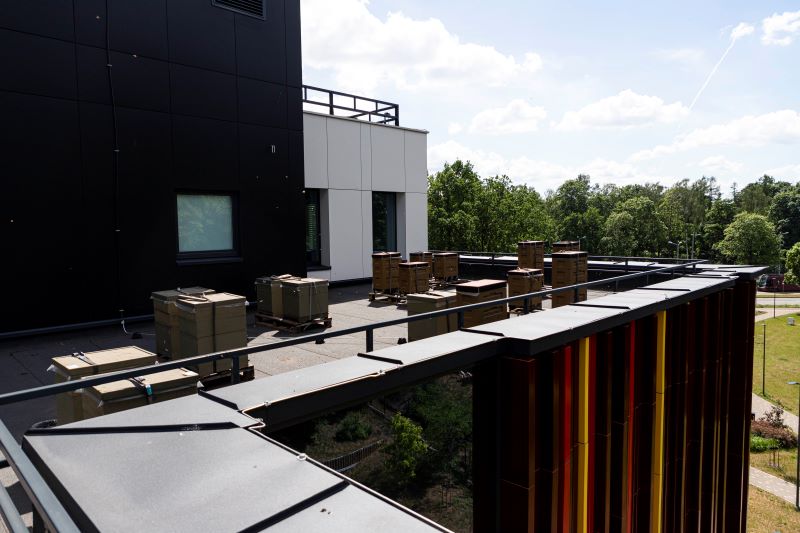 Beehives lined up on the roof of the RSU Pharmaceutical Education and Research Centre. Photo from RSU archive
Beehives lined up on the roof of the RSU Pharmaceutical Education and Research Centre. Photo from RSU archive
This activity is a feature of environmental diversity, which demonstrates boldness and how urban spaces can be used in many different ways.’
Harnessing the health benefits of Latvian honey
Later, the building's hosts – Prof. Dace Bandere, Dean of the RSU Faculty of Pharmacy, Asst. Prof. Agnese Brangule, Lead Researcher at the Department of Pharmaceutical Chemistry, and Ance Bārzdiņa, Acting Assistant at the Department of Pharmaceutical Chemistry, join us on the roof. We talk about bees, honey and, encouraged by the beekeeper, enjoy fresh honey straight from the frame. Delicious!
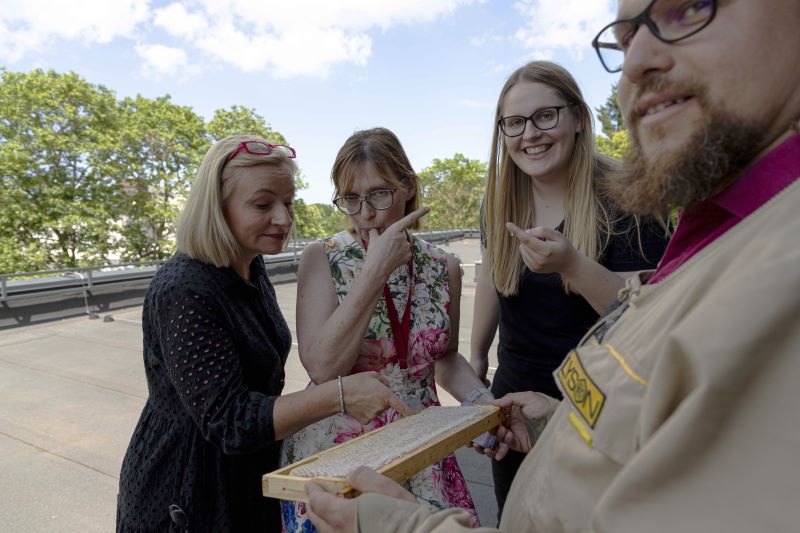 From the left: Dace Bandere, Agnese Brangule, Ance Bārzdiņa and Kārlis Krievkalns enjoying some fresh honey. Photo from RSU archive
From the left: Dace Bandere, Agnese Brangule, Ance Bārzdiņa and Kārlis Krievkalns enjoying some fresh honey. Photo from RSU archive
While ideas for how to use RSU rooftop honey in research are still being discussed, Asst. Prof. Brangule briefly talks about a study on honey that has already been carried out: ‘We collaborated with international researchers who had conducted several studies on manuka honey on a project at the Baltic Biomaterials Centre of Excellence.
Manuka honey is mainly collected in New Zealand and parts of Australia from the flowers of certain Leptospermum species that grow on manuka shrubs. Manuka honey is added to various fragile biomaterials and bioglasses to enhance their mechanical and antimicrobial properties. It is monofloral and has the best antimicrobial and anti-inflammatory properties. Moreover, it is the easiest material for studies as its botanical and chemical composition is well known.
This stung the Latvian researchers – we have our own honey after all! This is how the idea to study the properties of Latvian honey came about.
We conducted a study on the antimicrobial and antibiofilm properties of Latvian honey against wound infectious agents in collaboration with Krišs Dāvids Labsvārds, Scientific Assistant at the University of Latvia Department of Analytical Chemistry, Faculty of Chemistry, Ingus Skadiņš, Vice-Dean of the RSU Faculty of Medicine, and Assoc. Prof. at the Department of Biology and Microbiology, and researchers from Bior (Scientific Institute of Food Safety, Animal Health and Environment).
The study analysed 40 monofloral Latvian honey samples and compared them with manuka honey, looking for correlations between the honey's antimicrobial properties and its chemical composition. Particular attention was paid to the ability of honey to neutralise resistant bacteria and biofilms formed by bacteria.
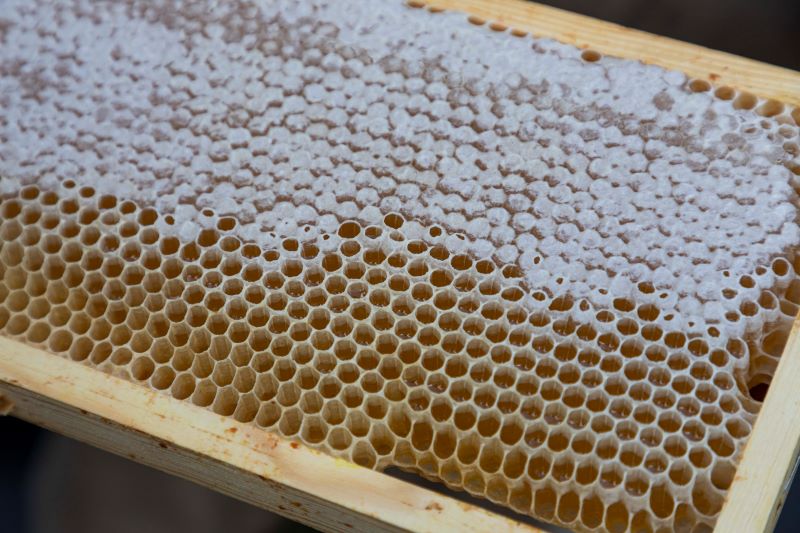 Close-up of honeycomb. Photo from RSU archive
Close-up of honeycomb. Photo from RSU archive
The study showed great potential for using Latvian honey in this field. Compared to manuka honey, it is much more difficult to obtain fully monofloral honey samples in Latvia, as many plants bloom simultaneously during the honey harvesting season, especially this year. This can create problems in obtaining honey with an identical composition several years in a row. The correlation between polyphenol analysis and antibacterial activity indicates that future studies should focus on honey samples with a specific botanical origin over several seasons and additional honey parameters that might affect antibacterial activity, such as methylglyoxal content, pesticide impact, or concentrations of certain polyphenols.
The successful collaboration resulted in a scientific publication* and a project was submitted to the Latvian Council of Science this year together with partners from the University of Latvia.
Analysing natural products poses a significant challenge and provides valuable experience for researchers due to their complex and variable composition, which is influenced by numerous external factors. The knowledge gained from such analysis is crucial for developing future biomaterials that effectively combine the best features of both synthetic and natural materials.
A grandfather’s legacy
From time to time, people come out on to the roof and inquire about the bees and beekeeper Krievkalns is happy to answer. We leave the roof to continue a more personal conversation.
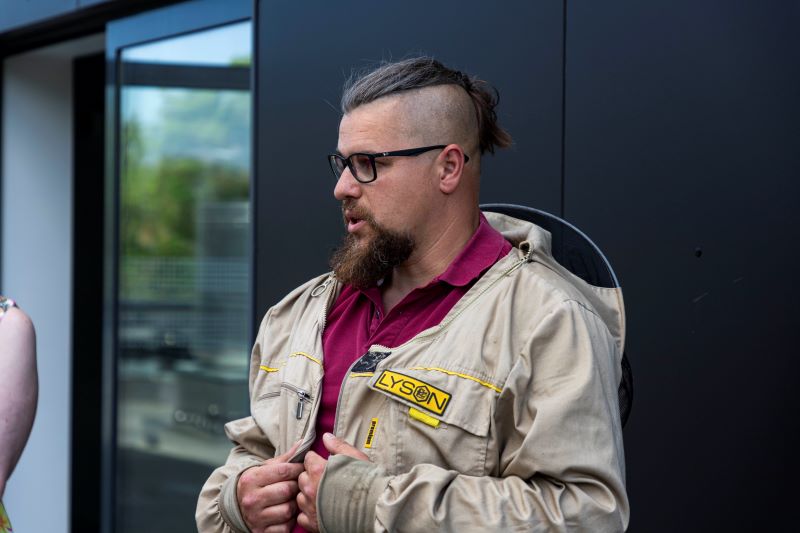 Portrait of Kārlis Krievkalns. Photo from RSU archive
Portrait of Kārlis Krievkalns. Photo from RSU archive
His story about becoming a beekeeper is sentimental: ‘I have known bees since childhood, because my grandfather was a beekeeper. Twelve years ago, when he was 90 years old and had about 50 to 60 bee colonies left, he said: “That's it, I can't do it anymore, I have to sell them”. I placed an ad, but I realised that empty hives wouldn’t sell for much, and we had about 20 at the time. They need to be full. We therefore caught some swarms of bees and...
I started enjoying the work and realised I didn't want to sell the hives anymore.
Life then presented me with an opportunity to return to my grandfather's home in Kroņauce. There is a lot of variation in beekeeping – how the bees swarm, which flowers bloom when, what the honey turns out like – that fascinates me! This work is full of adrenaline and surprises – every year is different! I'm always pleasantly surprised,’ says the beekeeper.
‘When I studied building management at the Riga Building College, I never imagined that I would one day become a beekeeper,’
he adds.
 The beekeeper holds up a frame, inspecting his bees. Photo from RSU archive
The beekeeper holds up a frame, inspecting his bees. Photo from RSU archive
Of course, the work is physically demanding. His hives have smaller frames that makes the work slightly easier. And sometimes the bees sting! ‘Bees sense if a person is stressed or ill. It's a mystery, but it has happened to me – I had pain in my shoulder, but the pain went away after I was stung there. Another day I had ear pain and had already made a doctor’s appointment, but a bee stung me on my ear as I was getting out of my car at home. It swelled and turned red, but after that subsided, my pain was gone…’ the beekeeper laughs. He adds that you shouldn’t mess with beekeepers, who can sting just like the bees themselves. ‘And they can give you something delicious,’ adds the photographer.
What does a beekeeper's annual work cycle look like? ‘There is work to do all year round! It might seem like a beekeeper comes over to check on the hives every now and again and that’s it. During the winters, we make frames, melt wax, repair hives, and process the honey and pollen produced in the summer. This involves drying the pollen, making bee bread, and packaging our products. We add 21 flavours to our honey using freeze-dried berries (cherries, strawberries, currants, blueberries, etc.) and the products need to be sold. People usually do not buy honey in summer: they do it in winter, during the virus and cold season.
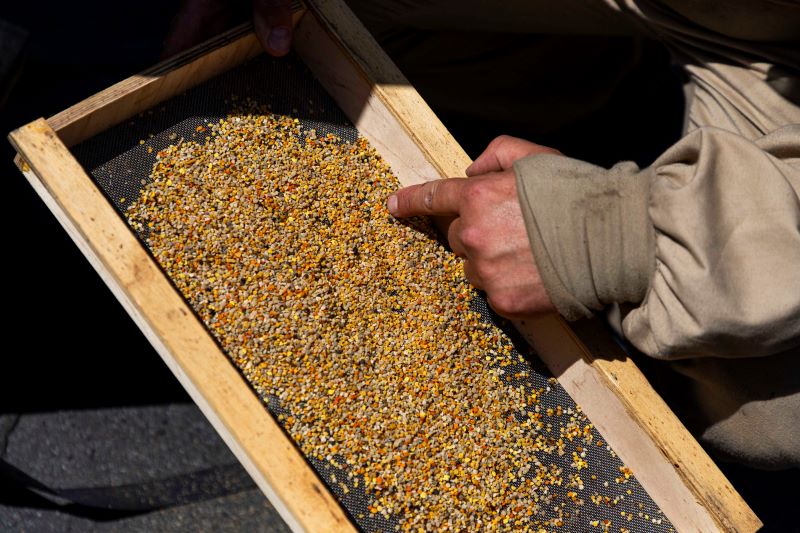 Close-up of pollen on a frame. Photo from RSU archive
Close-up of pollen on a frame. Photo from RSU archive
We spend our winters in the workroom, with the active season running from April to the end of September or October. By October, it already feels like we need a break. However, by the time January and February come around, beekeepers’ pulse rises again and we start wondering what is happening with our bees and we go to check the colonies. The most interesting thing is that every year is different. This year, everything blossomed very early, and May was unseasonably hot. For buyers, this means that honey will be available sooner. Usually, honey can be harvested by Midsummer, but this honey that I have in my hands, will be available two weeks earlier. However, there could be problems in July – if nothing is blooming, the bees will have nothing to eat, they will become more aggressive, and we will need to start feeding them. After all, bees collect honey for themselves, not for us. We harvest what they need, so we have to take care of them and give something back. If bees run out of food, we give them sugar syrup instead. Overall, beekeeping is a fascinating job!’ Krievkalns concludes. He promises to bring the bees back to the RSU roof again next year.
* "Antimicrobial and Antibiofilm Properties of Latvian Honey against Causative Agents of Wound Infections" in the journal Antibiotics.
Related news
 Time capsule laid at ceremony for construction of new RSU sports complexFor Students, Consolidation, For RSU Employees, Internal consolidation, Development
Time capsule laid at ceremony for construction of new RSU sports complexFor Students, Consolidation, For RSU Employees, Internal consolidation, Development


